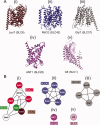Comparison of human solute carriers
- PMID: 20052679
- PMCID: PMC2866268
- DOI: 10.1002/pro.320
Comparison of human solute carriers
Abstract
Solute carriers are eukaryotic membrane proteins that control the uptake and efflux of solutes, including essential cellular compounds, environmental toxins, and therapeutic drugs. Solute carriers can share similar structural features despite weak sequence similarities. Identification of sequence relationships among solute carriers is needed to enhance our ability to model individual carriers and to elucidate the molecular mechanisms of their substrate specificity and transport. Here, we describe a comprehensive comparison of solute carriers. We link the proteins using sensitive profile-profile alignments and two classification approaches, including similarity networks. The clusters are analyzed in view of substrate type, transport mode, organism conservation, and tissue specificity. Solute carrier families with similar substrates generally cluster together, despite exhibiting relatively weak sequence similarities. In contrast, some families cluster together with no apparent reason, revealing unexplored relationships. We demonstrate computationally and experimentally the functional overlap between representative members of these families. Finally, we identify four putative solute carriers in the human genome. The solute carriers include a biomedically important group of membrane proteins that is diverse in sequence and structure. The proposed classification of solute carriers, combined with experiment, reveals new relationships among the individual families and identifies new solute carriers. The classification scheme will inform future attempts directed at modeling the structures of the solute carriers, a prerequisite for describing the substrate specificities of the individual families.
Figures






References
-
- Hediger MA, Romero MF, Peng JB, Rolfs A, Takanaga H, Bruford EA. The ABCs of solute carriers: physiological, pathological and therapeutic implications of human membrane transport proteins—Introduction. Pflugers Arch. 2004;447:465–468. - PubMed
-
- Povey S, Lovering R, Bruford E, Wright M, Lush M, Wain H. The HUGO Gene Nomenclature Committee (HGNC) Hum Genet. 2001;109:678–680. - PubMed
-
- Fredriksson R, Nordstrom KJ, Stephansson O, Hagglund MG, Schioth HB. The solute carrier (SLC) complement of the human genome: phylogenetic classification reveals four major families. FEBS Lett. 2008;582:3811–3816. - PubMed
Publication types
MeSH terms
Substances
Grants and funding
LinkOut - more resources
Full Text Sources

